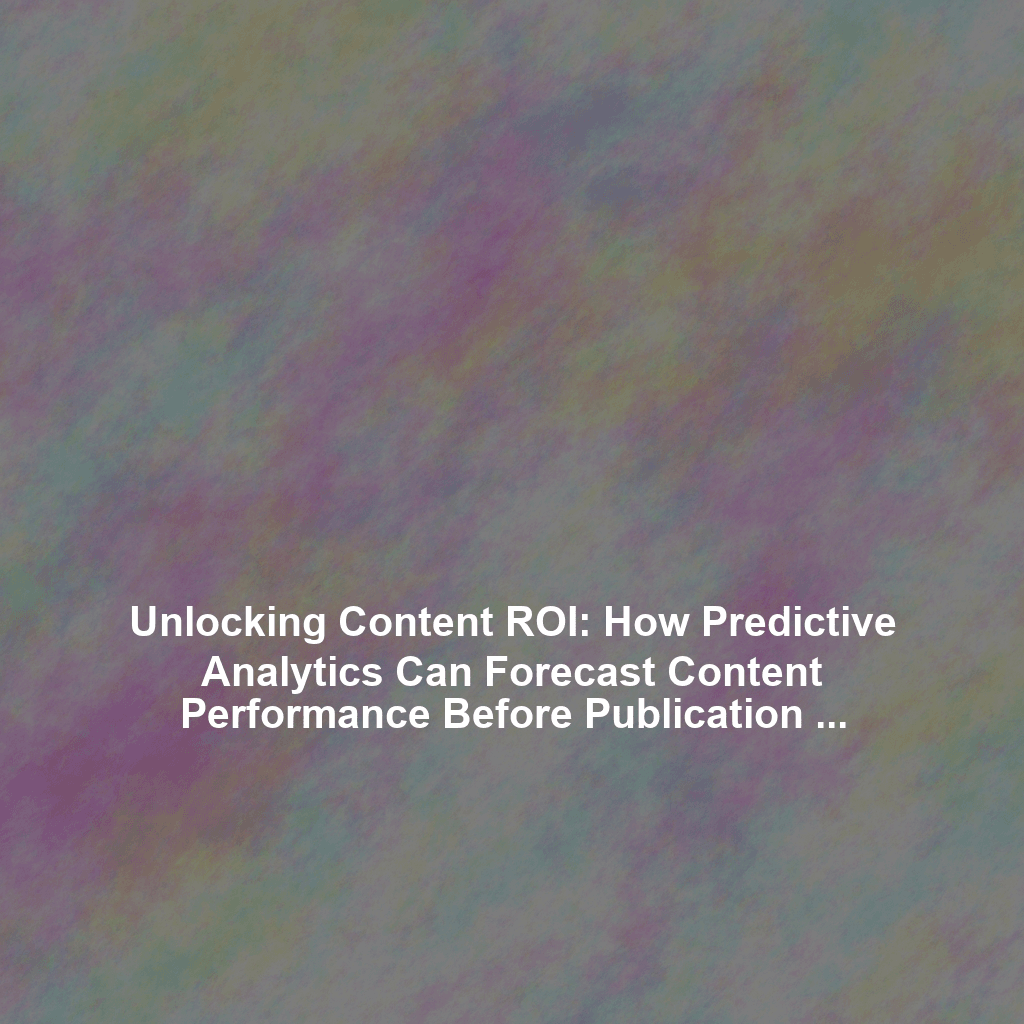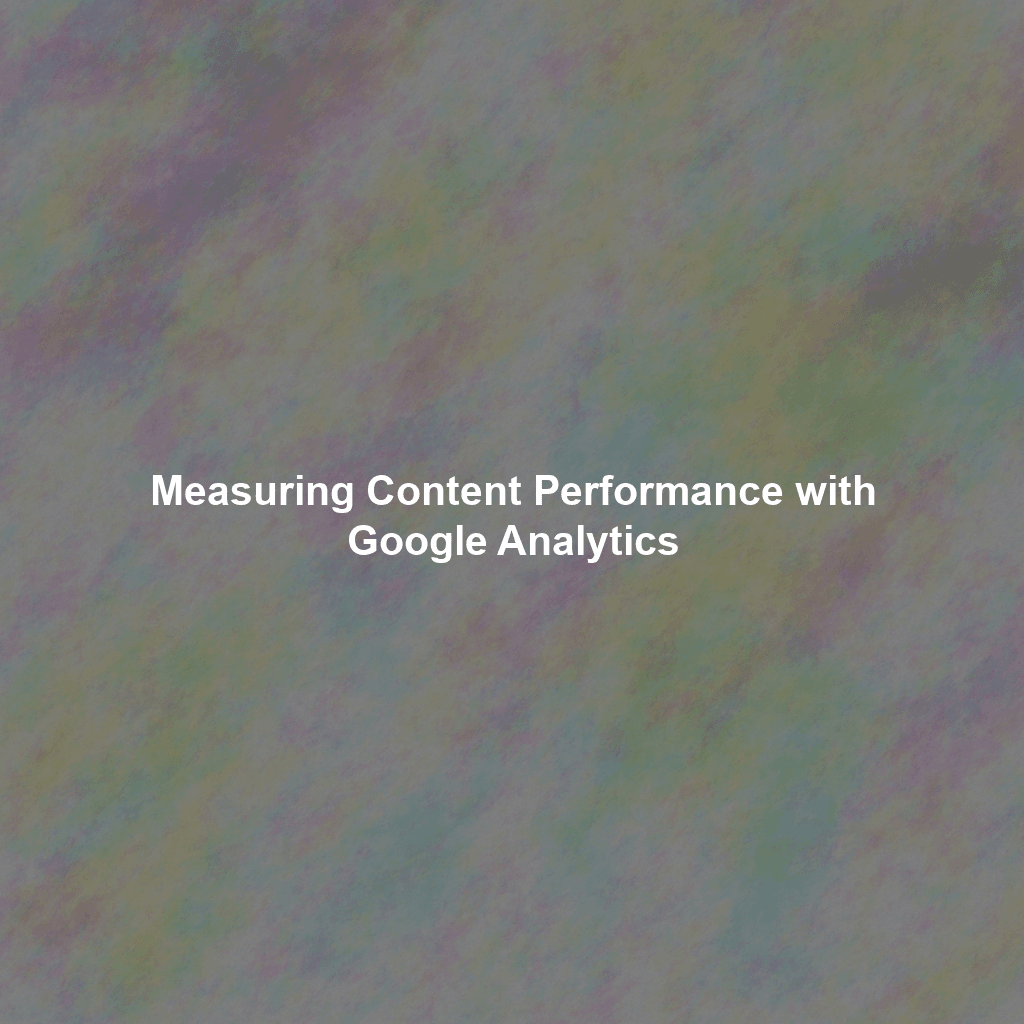The traditional landscape of content marketing, while evolving, has largely remained tethered to intuition, best practices, and post-publication analysis. You publish, you measure, you iterate. This reactive cycle, while offering learning opportunities, inherently carries a degree of inefficiency and uncaptured opportunity. Predictive content analytics upends this paradigm by applying sophisticated analytical frameworks and machine learning models to forecast content performance before it’s even released. This isn’t about mere guesswork; it’s about a rigorous, data-informed foresight that enables precise targeting and optimization.
Beyond the Intuitive: The Core Tenets of Predictive Content Analytics
At its heart, predictive content analytics is a methodology that leverages historical data, audience behavior, market trends, and competitive intelligence to construct models that predict the likely success metrics of a piece of content. Consider it an algorithmic crystal ball, albeit one grounded firmly in empirical data and statistical probability. The goal is clear: de-risk content investment and amplify its effectiveness.
The fundamental benefits are tangible and directly impact the bottom line:
- Elevated Engagement: By analyzing past successes and audience preferences, predictive models can pinpoint topics, formats, tones, and even sentence structures that are most likely to captivate your target demographic. This moves beyond surface-level demographics to a granular understanding of psychographics and behavioral patterns.
- Accelerated Conversions: Content is rarely an end in itself; it’s a vehicle for business objectives. Whether it’s lead generation, direct sales, increased subscriptions, or fostering brand advocacy, predictive analytics helps optimize content elements—from calls to action to placement—to drive specific conversion goals.
- Optimized SEO Performance: Search engine visibility remains paramount. Predictive analytics dissects successful content’s SEO attributes—keyword density, semantic relevance, content depth, internal and external linking strategies, and even readability scores—to guide future content creation that inherently aligns with search engine algorithms and, crucially, user intent. This means content that isn’t just crawlable but authoritative and trustworthy (E-E-A-T).
- Minimizing Resource Waste: Every piece of content represents an investment of time, effort, and capital. By predicting underperformance, organizations can reallocate resources from content unlikely to succeed to those with a high probability of generating significant ROI. This lean approach is essential for efficient operations.
- Data-Driven Strategic Alignment: The era of content strategy based on anecdotal evidence or subjective opinions is waning. Predictive analytics provides concrete data points and projections, allowing content strategy to be integrated seamlessly into broader business objectives, ensuring every piece of content serves a quantifiable purpose.
The Algorithmic Engine: How Predictive Analytics Operates
The efficacy of predictive content analytics hinges on a systematic, multi-stage process that transforms raw data into actionable intelligence.
- Comprehensive Data Aggregation and Cleansing: The bedrock of any robust predictive model is a rich, clean dataset. This extends beyond basic website analytics to encompass a broad spectrum of information:
- Historical Content Performance: This includes metrics such as unique page views, average time on page, bounce rate, scroll depth, social shares, comments, inbound links, and crucially, conversion rates directly attributable to content.
- User Behavioral Data: Data from Google Analytics, CRM systems, and marketing automation platforms revealing user demographics, interests, historical purchase behavior, content consumption patterns, and engagement pathways.
- Social Listening and Trend Analysis: Monitoring social media platforms for trending topics, influencer discussions, sentiment analysis around specific keywords or industry themes, and competitive content performance. Tools like Brandwatch or Sprout Social can be instrumental here.
- Market Intelligence and Industry Trends: Analysis of broader economic indicators, regulatory changes, technological advancements, and emerging consumer behaviors that could impact content relevance and demand. Sources like government reports (e.g., from the Bureau of Economic Analysis or industry-specific regulatory bodies), academic research (e.g., published in reputable journals), and reputable industry analyst reports (e.g., Gartner, Forrester) provide invaluable context.
- SEO Data: Deep dives into keyword research tools (e.g., SEMrush, Ahrefs), backlink profiles of high-performing content, search console data for impressions and click-through rates, and competitive keyword strategies.
This disparate data must be meticulously collected, standardized, and cleaned to remove inconsistencies, duplicates, and irrelevant entries. The adage “garbage in, garbage out” applies emphatically here.
- Strategic Feature Engineering: Raw data, while abundant, needs refinement. Feature engineering is the art and science of transforming raw data into features—variables that are most predictive of content success. This involves creating new variables or transforming existing ones to better highlight underlying patterns. Examples include:
- Content Attributes: Word count, reading level (e.g., Flesch-Kincaid grade level), presence of multimedia, internal link density, external link count and domain authority of linked sites, number of headings/subheadings, use of bullet points or numbered lists.
- Topical Granularity: Categorizing content beyond broad topics to more specific sub-themes, and analyzing the “freshness” or evergreen nature of a topic.
- Semantic Analysis: Using Natural Language Processing (NLP) to extract entities, concepts, and overall sentiment from content, understanding the underlying meaning rather than just keyword presence.
- Authoritative Signals: Incorporating attributes related to the author’s expertise and authority, such as their LinkedIn connections, publications, and external mentions, to align with Google’s E-E-A-T guidelines.
- Temporal Features: Analyzing the optimal publishing times and days for specific content types or topics based on historical audience engagement patterns.
- Model Selection, Building, and Training: With a refined dataset and engineered features, the next step involves selecting and training machine learning models. The choice of model depends on the prediction objective:
- Regression Models (e.g., Linear Regression, Random Forest Regressor): Ideal for predicting continuous outcomes like estimated page views, average time on page, or projected conversion rates. These models identify the mathematical relationship between input features and the numerical outcome.
- Classification Models (e.g., Logistic Regression, Support Vector Machines, Neural Networks): Used when the outcome is categorical, such as predicting whether a piece of content will achieve “high engagement” (yes/no), or whether it will rank in the top 10 for a specific keyword.
- Time Series Analysis (e.g., ARIMA, Prophet): Particularly useful for forecasting future content trends, seasonal variations in content consumption, or the longevity of content performance based on historical temporal patterns.
These models are trained on a substantial portion of the historical, engineered data. This training process allows the algorithm to “learn” the complex, often non-linear, relationships between the features and the desired outcome.
- Rigorous Model Evaluation and Iterative Refinement: A model is only as valuable as its accuracy. Post-training, the model is rigorously evaluated against a separate, unseen dataset (the “test set”) to assess its predictive power. Metrics like R-squared (for regression), precision, recall, F1-score, and AUC-ROC (for classification) are used to quantify performance. Discrepancies between predicted and actual outcomes inform iterative refinements to the model, features, or even the initial data collection strategy. This continuous feedback loop ensures the model remains robust and relevant. For instance, if a model consistently overestimates engagement for long-form content, it might signal a need to re-evaluate the “readability” feature or introduce new variables related to content structure.
- Actionable Prediction and Strategic Implementation: The ultimate output is a trained, validated model that can ingest new content attributes (e.g., a draft blog post, a proposed video topic) and output a predicted performance score or category. This foresight is where the ROI manifests. Content teams can then:
- Prioritize content ideas with the highest predicted ROI.
- Optimize content elements (headlines, subheadings, calls to action, image selection) based on model insights before publication.
- Adjust publishing schedules for maximum impact.
- Tailor content distribution strategies based on predicted audience receptivity.
- Identify content gaps or opportunities that competitors might be missing.
Real-World Impact: Predictive Analytics in Practice
The application of predictive content analytics spans across industries, offering tailored insights that drive specific business outcomes.
- E-commerce Giants: An online retailer might use predictive analytics to analyze customer reviews, product specifications, and past sales data to forecast which new product descriptions will lead to the highest conversion rates. They could identify that descriptions highlighting “eco-friendly materials” and featuring user-generated photos consistently outperform others. This informs not only future product copy but also inventory decisions.
- Leading Media Outlets: News organizations, particularly in a landscape where clickbait reigns but journalistic integrity is vital, can use predictive models to forecast which news stories or investigative pieces are most likely to garner high reader engagement and social shares without sacrificing editorial standards. This involves analyzing topics, writing style, sentiment, and the perceived “newsworthiness” based on real-time data from millions of articles. This is critical for optimizing resource allocation in fast-paced newsrooms. For example, a model might predict that an in-depth analysis of a recent Supreme Court ruling will have higher long-term engagement and shareability than a breaking news alert, guiding resource allocation.
- Financial Services Innovators: Investment firms can leverage predictive analytics to determine which types of financial advice articles, market analyses, or investment strategy guides resonate most with different client segments. By analyzing past consumption patterns, client demographics, and market volatility, they can tailor content to attract specific investor profiles, such as risk-averse retirees versus growth-oriented young professionals. This directly impacts client acquisition and retention.
- Healthcare Providers and Educators: Public health organizations and medical institutions can utilize predictive analytics to design health education materials that are most effective for specific patient demographics. For instance, a model might suggest that animated videos explaining complex medical procedures in simple language are more effective for a younger, less health-literate audience, while detailed academic papers are preferred by researchers or medical professionals. This ensures health information has maximum impact and promotes better public health outcomes. You can find excellent examples of data-driven health communication from organizations like the CDC (Centers for Disease Control and Prevention) or the World Health Organization (WHO), both of which increasingly use data to inform their public messaging strategies.
Charting the Course: Implementing Predictive Content Analytics
Adopting predictive content analytics doesn’t necessitate an immediate, radical overhaul. A pragmatic, phased approach is often more effective, especially for organizations new to advanced analytics.
- Clearly Define Objectives: Begin by articulating what specific content marketing goals you aim to achieve. Is it a 20% increase in qualified leads from blog posts? A 15% reduction in content production costs due to fewer underperforming assets? An improvement in organic search visibility for cornerstone content? Clear, measurable objectives are critical.
- Inventory and Consolidate Data Sources: Conduct an audit of all existing data sources related to content performance, website analytics, social media, and market intelligence. This may include Google Analytics, Google Search Console, CRM data, marketing automation platforms, social media insights, and third-party SEO tools. Prioritize data cleanliness and integration.
- Strategic Tool Selection: While advanced predictive analytics can involve custom machine learning models, numerous off-the-shelf “content intelligence” platforms now integrate many predictive capabilities. Examples include tools that offer content scoring, topic clustering, and competitive content gap analysis, often powered by AI. For more sophisticated analyses, consider open-source machine learning libraries like Python’s Scikit-learn or R, paired with data visualization tools like Tableau or Power BI.
- Initiate a Pilot Project: Start small. Select a specific content type or a niche topic area for your initial predictive analytics pilot. This allows you to test hypotheses, refine your methodology, and demonstrate tangible value without significant upfront investment or organizational disruption. For example, focus on predicting the performance of “how-to” articles within a specific product category.
- Embrace Iteration and Continuous Improvement: Predictive models are not static. The digital landscape, audience behaviors, and search engine algorithms are constantly evolving. Therefore, continuous monitoring of model performance, periodic retraining with fresh data, and adaptive adjustments to content strategy are paramount. This iterative process ensures the models remain accurate and your content strategy stays ahead of the curve. This is an ongoing journey of learning and optimization.
The Inevitable Future: AI-Powered Content Precision
The trajectory is clear: artificial intelligence and machine learning will continue to democratize and enhance predictive capabilities across all business functions, with content marketing being a prime beneficiary. My own company, Content Hurricane, is a testament to this future, focusing on delivering AI-driven, scalable, and E-E-A-T aligned content specifically for WordPress, helping companies dramatically increase inbound leads. The ability to forecast content performance with increasing accuracy will move from a competitive advantage to a fundamental requirement for effective content strategy. We will see more sophisticated models that can not only predict what content will perform well but also why, offering deeper, more nuanced insights into audience psychology and market dynamics. This will lead to content that is not only highly effective but also deeply personalized and impactful.
In closing, the shift from reactive content creation to proactive, data-driven content prediction is not merely an incremental improvement; it’s a strategic leap. By embracing predictive content analytics, organizations can move beyond intuitive guesswork to make high-IQ, ROI-maximizing decisions about their content investments. This is how you don’t just participate in the digital landscape; you dominate it.
#PredictiveAnalytics #ContentMarketing #AIDrivenContent #SEOStrategy #DataDrivenMarketing #ContentROI #MachineLearningInMarketing #FutureOfContent #DigitalTransformation
 Skip to content
Skip to content

